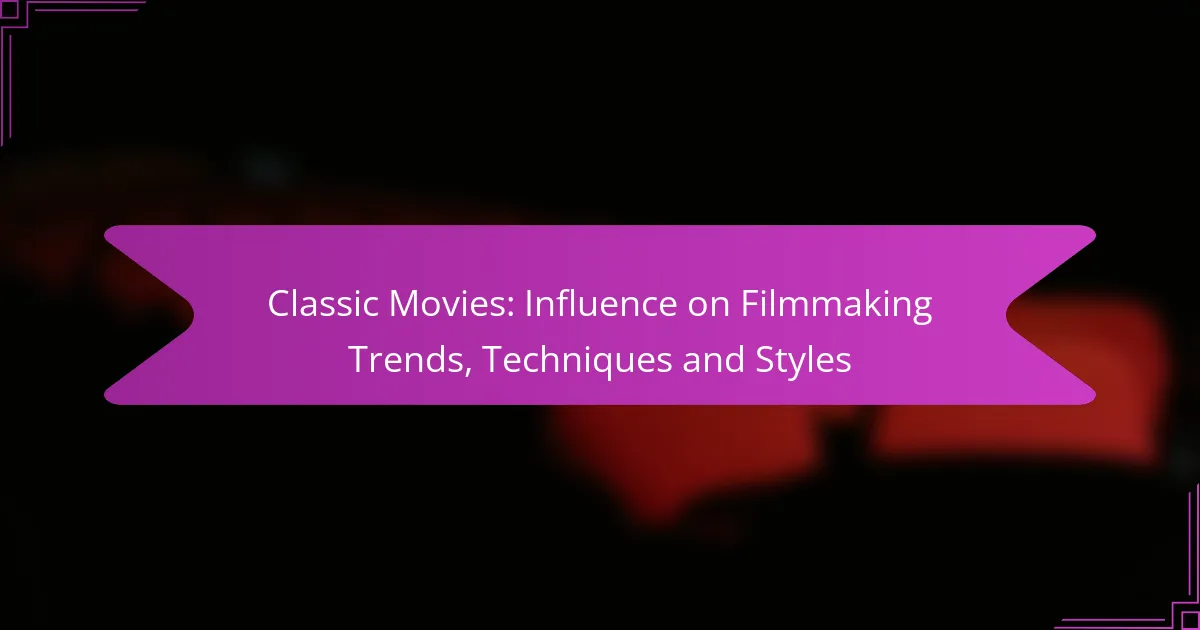Classic films play a pivotal role in shaping modern pop culture, influencing trends across fashion, music, and storytelling. Their timeless themes and memorable characters not only resonate with audiences today but also inspire a new generation of creators. As nostalgia drives the resurgence of remakes and references in contemporary media, the legacy of these films continues to leave a profound impact on the cinematic landscape.
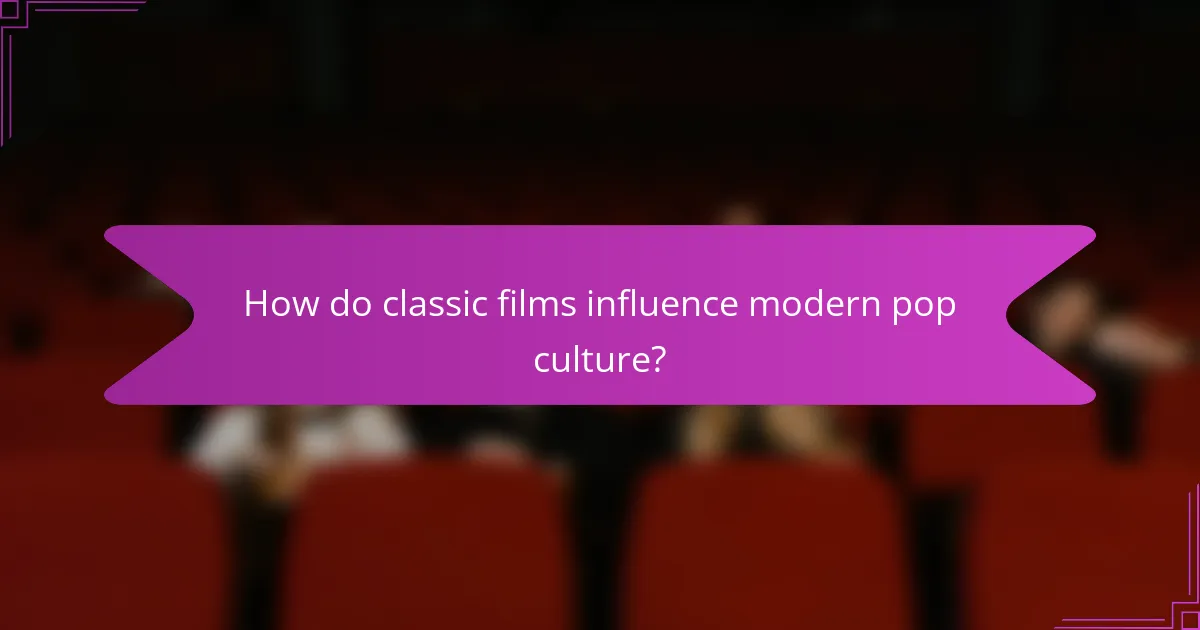
How do classic films influence modern pop culture?
Classic films significantly shape modern pop culture by setting trends in various creative fields, including fashion, music, and storytelling. Their enduring themes and iconic characters continue to resonate, inspiring new generations of artists and creators.
Impact on fashion trends
Classic films often introduce distinctive styles that become fashion staples. For instance, the elegant dresses worn by Audrey Hepburn in “Breakfast at Tiffany’s” have inspired countless modern designs, while Marlon Brando’s leather jacket in “The Wild One” remains a symbol of rebellion.
Fashion designers frequently draw from these timeless looks, incorporating vintage elements into contemporary collections. This blending of past and present allows classic films to maintain a lasting influence on today’s fashion landscape.
Influence on music and art
The soundtracks of classic films have left a profound mark on modern music, with many contemporary artists sampling or referencing iconic scores. For example, the jazz-infused soundtrack of “Casablanca” continues to inspire musicians across genres.
In visual arts, classic films serve as a rich source of inspiration for painters and digital artists. The cinematography and set designs often evoke a specific mood or aesthetic that artists strive to replicate or reinterpret in their own works.
Shaping contemporary storytelling
Classic films have established narrative structures and character archetypes that are still prevalent in today’s storytelling. The hero’s journey, as seen in films like “The Wizard of Oz,” continues to be a blueprint for many modern narratives across film and literature.
Moreover, themes of love, conflict, and redemption found in classic cinema resonate with audiences, influencing scriptwriters and directors. By studying these films, creators can learn effective techniques for engaging storytelling that captivates viewers.

What are the key trends in classic films?
Key trends in classic films include the resurgence of remakes and reboots, as well as the integration of classic film references in contemporary media. These trends reflect a growing nostalgia and a desire to connect new audiences with the cinematic past.
Resurgence of remakes and reboots
The film industry has seen a significant increase in the production of remakes and reboots of classic films. This trend capitalizes on established stories and characters, appealing to both nostalgic viewers and new audiences. For example, films like “A Star is Born” and “The Lion King” have been reimagined for modern viewers, often with updated technology and contemporary themes.
When considering remakes, filmmakers must balance honoring the original material with introducing fresh perspectives. Successful reboots often retain iconic elements while innovating in areas like casting, special effects, and storytelling techniques. However, poorly executed remakes can face backlash from fans of the original.
Integration of classic film references in new media
Classic films are frequently referenced in new media, including television shows, video games, and online content. This integration serves to enrich narratives and create a sense of continuity within popular culture. For instance, shows like “Stranger Things” heavily draw on 1980s film aesthetics and themes, appealing to both older and younger audiences.
Content creators can leverage classic film references to evoke emotions or establish character traits. However, it is essential to ensure that these references are relevant and enhance the story rather than distract from it. A well-placed homage can resonate deeply, while forced references may alienate viewers unfamiliar with the original material.
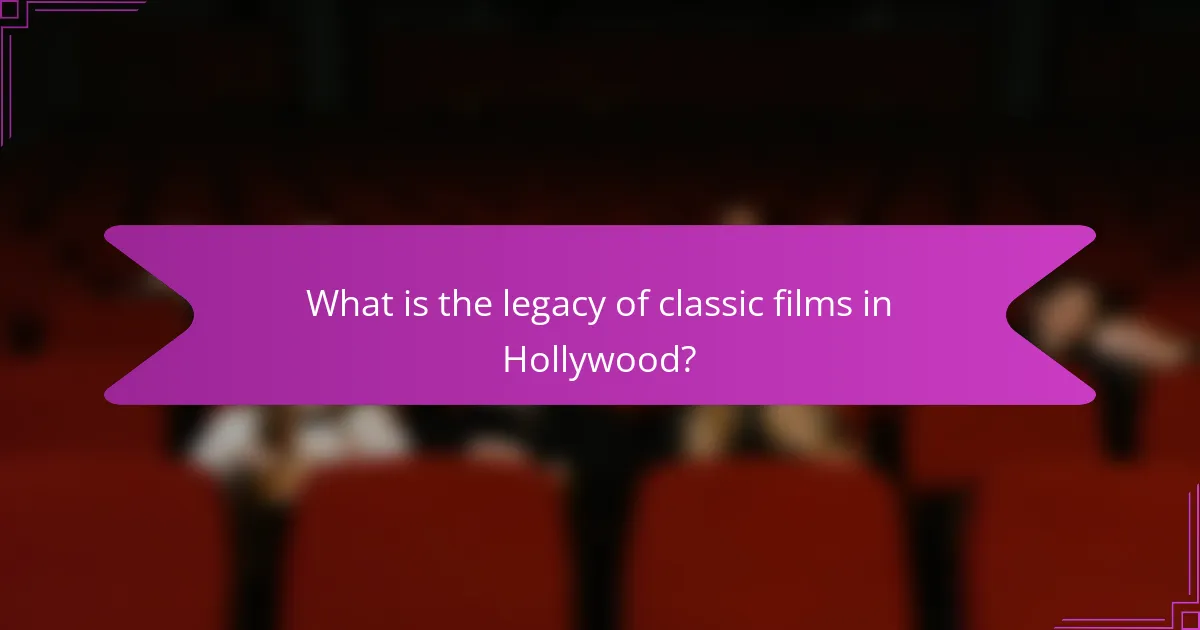
What is the legacy of classic films in Hollywood?
The legacy of classic films in Hollywood is profound, shaping the industry’s storytelling, visual style, and cultural impact. These films set standards that continue to influence filmmakers and audiences alike, creating a lasting imprint on modern cinema.
Enduring cinematic techniques
Classic films introduced a variety of cinematic techniques that remain relevant today. Techniques such as deep focus, montage editing, and innovative lighting have become foundational elements in filmmaking. For instance, the use of montage in films like “Battleship Potemkin” has influenced how stories are visually constructed, emphasizing emotional and narrative pacing.
Filmmakers today often draw inspiration from these techniques to enhance their storytelling. Understanding and applying these methods can elevate a film’s production quality and viewer engagement. Aspiring directors should study classic films to grasp the origins of these techniques and how they can be adapted for contemporary narratives.
Influence on film genres
Classic films have significantly shaped various film genres, establishing conventions that define them. For example, the film noir genre, characterized by its moral ambiguity and visual style, was solidified by classics like “Double Indemnity” and “The Maltese Falcon.” These films set a template that modern filmmakers still reference when creating suspenseful narratives.
Moreover, genres such as musicals and westerns owe much of their development to classic cinema. The integration of music and dance in films like “Singin’ in the Rain” showcased how storytelling could be enhanced through performance. Understanding these influences helps filmmakers recognize genre expectations and innovate within those frameworks.
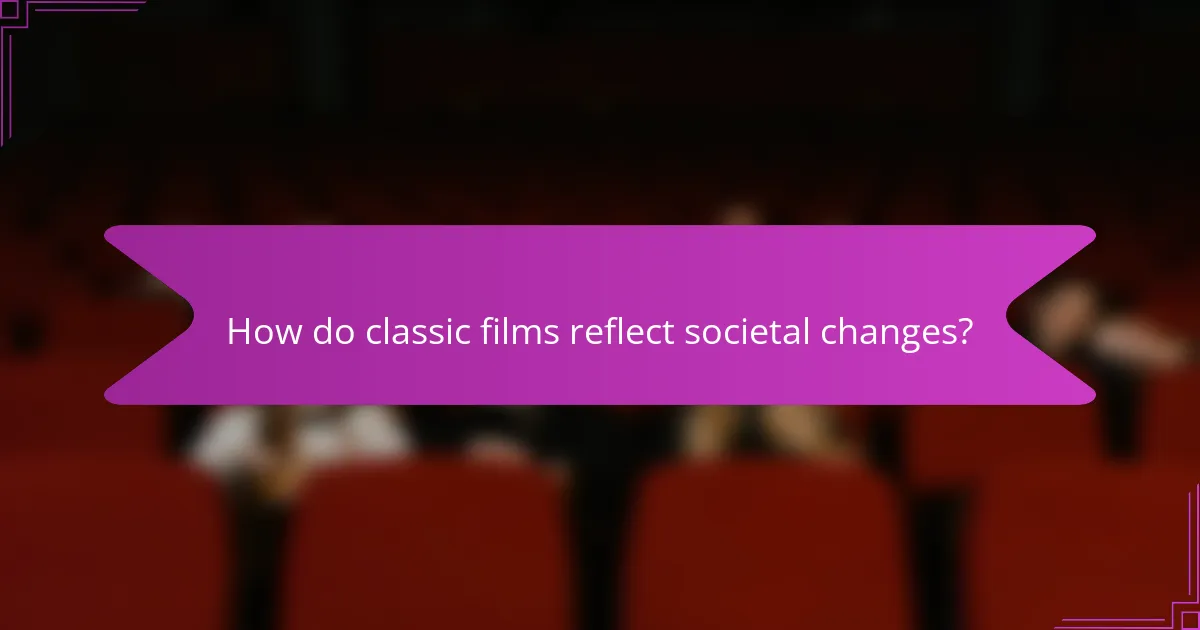
How do classic films reflect societal changes?
Classic films serve as a mirror to societal changes, showcasing evolving norms, values, and issues over time. They capture the zeitgeist of their eras, influencing and reflecting public sentiment on various topics.
Representation of cultural shifts
Classic films often highlight significant cultural shifts, such as changes in gender roles, racial dynamics, and social attitudes. For example, films from the 1950s may depict traditional family structures, while those from the 1970s and beyond often challenge these norms, showcasing more diverse and complex characters.
These representations can influence public perception and acceptance of cultural changes. Movies like “Guess Who’s Coming to Dinner” (1967) played a crucial role in addressing [censured] relationships, contributing to broader societal acceptance.
Depiction of historical events
Many classic films dramatize historical events, providing audiences with a narrative that shapes their understanding of the past. Films like “Schindler’s List” (1993) and “Saving Private Ryan” (1998) not only entertain but also educate viewers about significant moments in history, often evoking strong emotional responses.
These depictions can lead to renewed interest in historical topics and discussions, influencing how society remembers and interprets past events. However, it is essential to approach these films critically, recognizing that artistic license may alter factual accuracy for dramatic effect.

What are the criteria for a film to be considered a classic?
A film is typically considered a classic if it has received significant critical acclaim, has stood the test of time, and continues to resonate with audiences across generations. Key factors include artistic merit, cultural impact, and lasting popularity.
Critical acclaim and awards
Critical acclaim often serves as a primary indicator of a classic film. Films that receive prestigious awards, such as Oscars or Golden Globes, are frequently recognized for their artistic achievements and storytelling prowess. For instance, movies like “Casablanca” and “The Godfather” have garnered numerous accolades, solidifying their status in cinematic history.
In addition to awards, critical reviews from respected sources can contribute to a film’s classic status. A film that consistently receives high ratings from critics and audiences alike is more likely to be remembered and celebrated over time.
Enduring popularity over decades
Enduring popularity is a crucial criterion for a film’s classification as a classic. Films that remain relevant and continue to attract new viewers years or even decades after their release demonstrate a timeless appeal. For example, “Star Wars” and “Gone with the Wind” have maintained their popularity through re-releases, merchandise, and cultural references.
Additionally, a classic film often influences subsequent works in the industry, shaping trends and inspiring filmmakers. This ongoing impact on pop culture helps solidify a film’s legacy and ensures its place in the hearts of audiences for generations to come.

How do classic films impact global cinema?
Classic films significantly shape global cinema by establishing storytelling techniques, visual styles, and cultural references that resonate across borders. Their influence can be seen in the works of contemporary filmmakers who draw inspiration from these timeless narratives and cinematic innovations.
Influence on international filmmakers
International filmmakers often look to classic films for inspiration in crafting their own stories and visual styles. For instance, directors from various countries have adopted techniques such as nonlinear storytelling and character-driven plots, which were popularized by classic cinema. This cross-pollination enriches the global film landscape, allowing diverse voices to emerge while paying homage to the past.
Many renowned directors, like Martin Scorsese and Quentin Tarantino, openly acknowledge their debt to classic films, demonstrating how these works continue to inform modern filmmaking. Aspiring filmmakers can benefit from studying these classics to understand narrative structure, character development, and visual composition.
Cross-cultural adaptations
Classic films often serve as a foundation for cross-cultural adaptations, where stories are reimagined to fit different cultural contexts. For example, films like “The Seven Samurai” have inspired numerous adaptations, including “The Magnificent Seven,” showcasing how universal themes can transcend cultural boundaries. These adaptations not only introduce classic narratives to new audiences but also allow for cultural reinterpretation.
When adapting classic films, it’s essential to consider the cultural nuances that may affect the story’s reception. Filmmakers should aim to preserve the original’s essence while making it relatable to the target audience. This balance can enhance the film’s appeal and ensure its relevance in a different cultural setting.
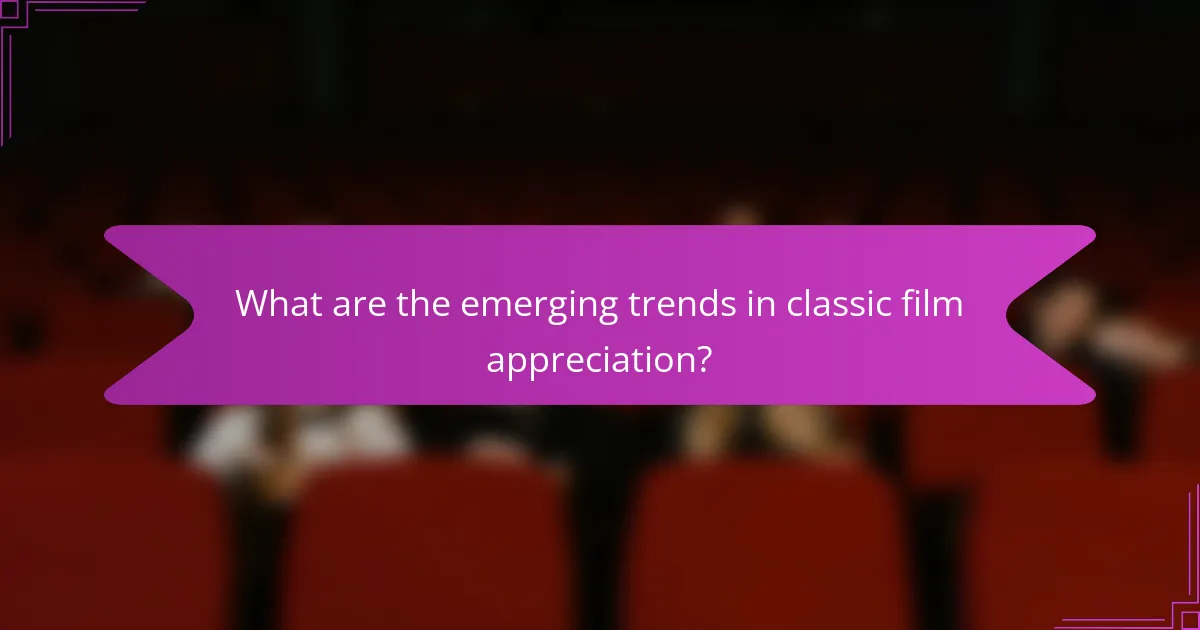
What are the emerging trends in classic film appreciation?
Emerging trends in classic film appreciation highlight a growing engagement with vintage cinema, driven by technological advancements and cultural shifts. Audiences are increasingly seeking out classic films through new platforms and initiatives that promote their preservation and accessibility.
Rise of streaming platforms
The rise of streaming platforms has significantly transformed how classic films are accessed and appreciated. Services like Netflix, Amazon Prime, and specialized platforms such as Criterion Channel offer extensive libraries of classic films, making them readily available to a global audience.
This accessibility encourages new viewers to explore classic cinema, often leading to increased discussions and analyses on social media. Many platforms also curate themed collections, providing context and enhancing the viewing experience.
Increased interest in film preservation
There is a notable increase in interest surrounding film preservation, with organizations and institutions working to restore and maintain classic films. This trend is fueled by a recognition of the cultural and historical significance of these films, prompting efforts to digitize and archive them for future generations.
Film festivals and preservation initiatives often showcase restored classics, allowing audiences to experience these works in high quality. Additionally, educational programs are emerging, focusing on the importance of preserving film heritage, which helps cultivate a deeper appreciation among younger audiences.

What future trends can we expect in classic film analysis?
Future trends in classic film analysis will likely focus on the integration of technology, evolving cultural contexts, and interdisciplinary approaches. Analysts will increasingly utilize digital tools and platforms to enhance understanding and accessibility of classic films.
Integration of technology in film studies
The integration of technology in film studies is transforming how classic films are analyzed and appreciated. Tools such as digital archives, streaming services, and virtual reality are making it easier for scholars and enthusiasts to access and study films from various eras.
For instance, platforms like Criterion Channel and Kanopy provide curated selections of classic films, allowing users to explore thematic collections and historical contexts. Additionally, software for film analysis can help dissect scenes, enabling a deeper understanding of cinematography and editing techniques.
As technology continues to evolve, film studies will likely incorporate AI-driven analytics for audience engagement and sentiment analysis, offering new insights into how classic films resonate with contemporary viewers. Embracing these tools can enhance research quality and broaden the reach of classic cinema appreciation.


